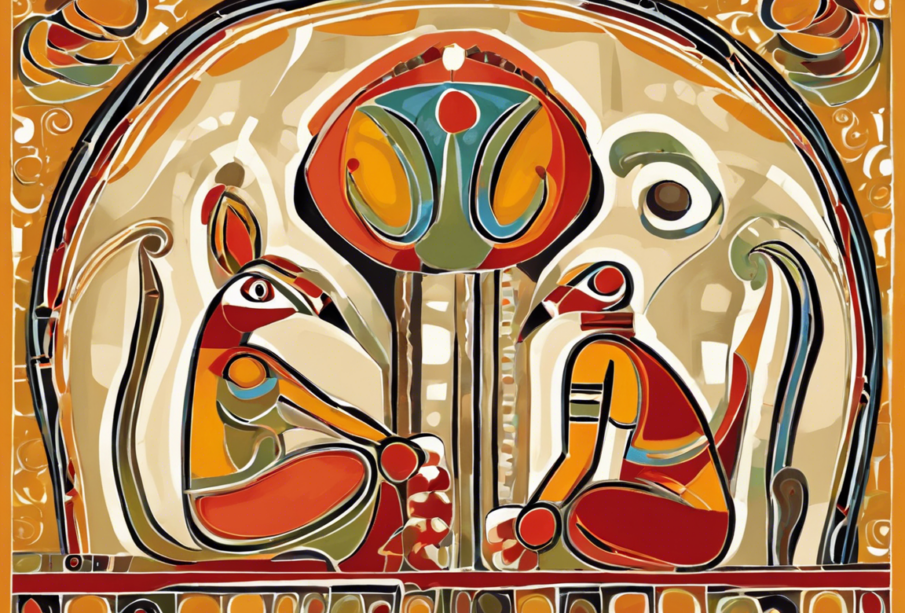Exploring the Folk Art of Jamini Roy

The folk art of Jamini Roy holds a significant place in the cultural heritage of India. Born in 1887 in a small village in West Bengal, Roy went on to become one of the most prominent and celebrated artists in the country. His unique style, which drew inspiration from traditional Indian folk art forms, has left a lasting impact on the art world.
Background and Influences
Jamini Roy’s artistic journey began with formal training in Western academic art at the Government School of Art in Kolkata. However, he soon realized that his true calling lay in exploring the rich artistic traditions of his homeland. Roy was deeply influenced by the traditional Bengali patachitra (scroll painting) and kalamkari (hand-painted or block-printed cotton textile) styles. He also drew inspiration from the Kalighat pat, a vibrant style of painting that originated in the Kalighat temple area of Kolkata.
The Evolution of Style
Roy’s early works reflected a fusion of Western techniques and Indian motifs. However, he gradually moved away from this hybrid style and began to develop a more indigenous and simplistic approach. He pared down his compositions to their basic elements, using bold lines and vibrant colors to create striking images. Roy’s works often featured rural scenes, mythological figures, and everyday life, executed in a distinctive flat style.
Key Characteristics
-
Bold Lines: Roy’s paintings are characterized by bold, confident lines that define the forms and add a sense of dynamism to the compositions.
-
Vibrant Colors: He made extensive use of bright, primary hues such as red, blue, and yellow, which lent a sense of vitality to his works.
-
Simplified Forms: Roy’s style is marked by the simplification of forms, with an emphasis on capturing the essence of the subject rather than its detailed representation.
-
Folk Motifs: His works often incorporated motifs and symbols drawn from traditional folk art, adding a layer of cultural richness to his paintings.
Legacy and Impact
Jamini Roy’s contributions to Indian art are immense. By drawing inspiration from folk art traditions and infusing them with his unique vision, he created a body of work that was both innovative and deeply rooted in the country’s cultural heritage. His influence can be seen in the work of subsequent generations of artists who have continued to explore and celebrate India’s rich artistic legacy.
Jamini Roy: A National Treasure
In recognition of his immense talent and contributions to the art world, Jamini Roy was honored with several prestigious awards, including the Padma Bhushan by the Government of India. Today, his paintings are highly sought after by collectors and art enthusiasts around the world, fetching high prices at auctions and galleries.
FAQs (Frequently Asked Questions)
-
What materials did Jamini Roy use for his paintings?
Jamini Roy primarily worked with natural materials such as handmade paper, natural dyes, and pigments sourced from minerals and vegetables. -
What themes did Jamini Roy explore in his art?
Roy’s art often revolved around mythological figures, Bengali folklore, everyday life, and rural scenes, reflecting his deep connection to his cultural roots. -
How did Jamini Roy’s style evolve over his career?
Initially influenced by Western academic art, Roy gradually moved towards a more simplified and indigenous style that drew inspiration from traditional Indian folk art. -
Where can one view Jamini Roy’s paintings today?
Jamini Roy’s works can be found in various museums and art galleries across India, including the National Gallery of Modern Art in New Delhi and the Victoria Memorial Hall in Kolkata. -
What sets Jamini Roy apart from other Indian artists of his time?
Jamini Roy’s unique blend of traditional folk art influences and modern sensibilities set him apart from his contemporaries, establishing him as a pioneer in the Indian art scene.

